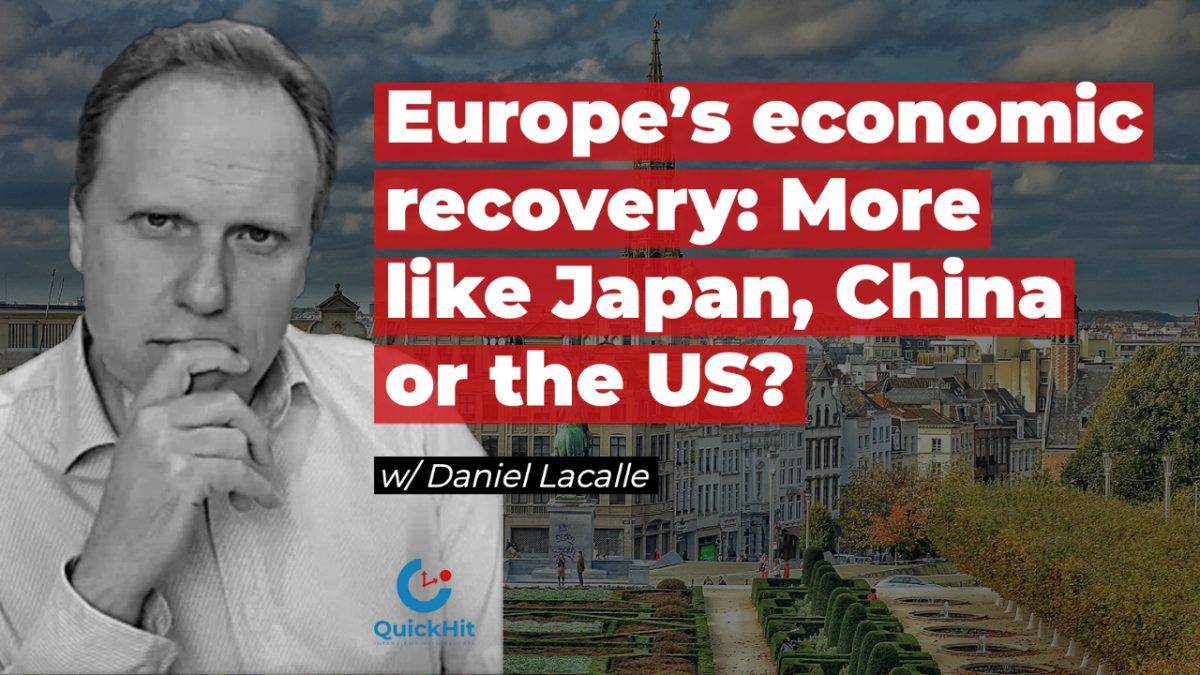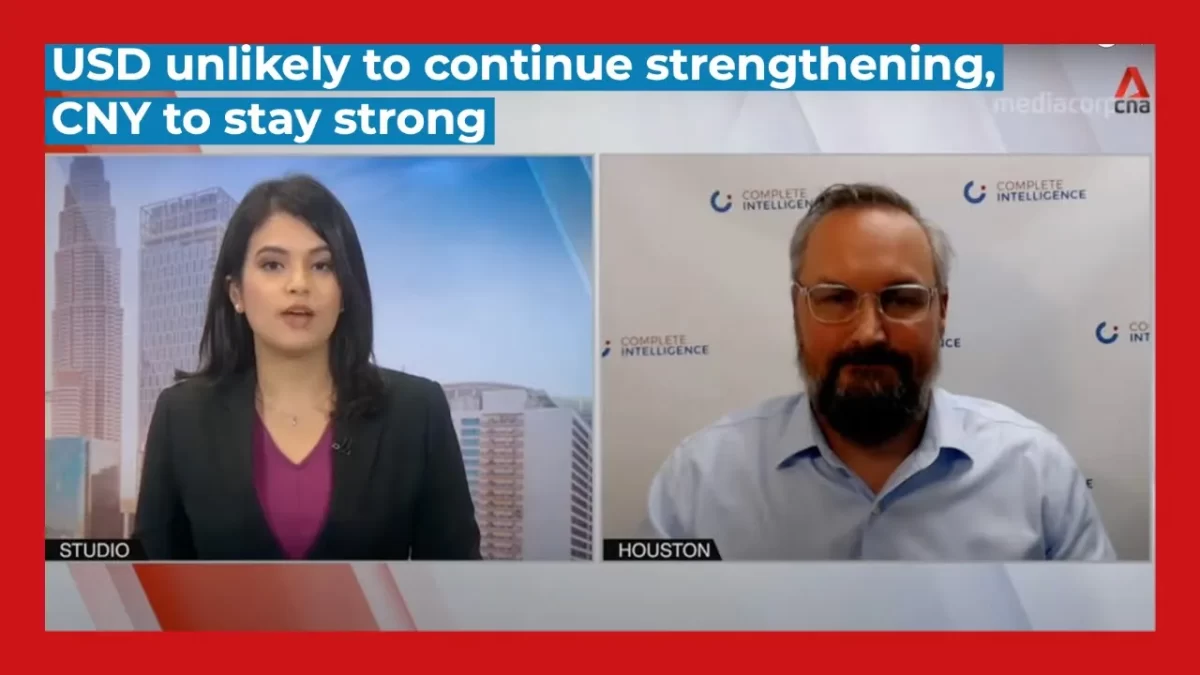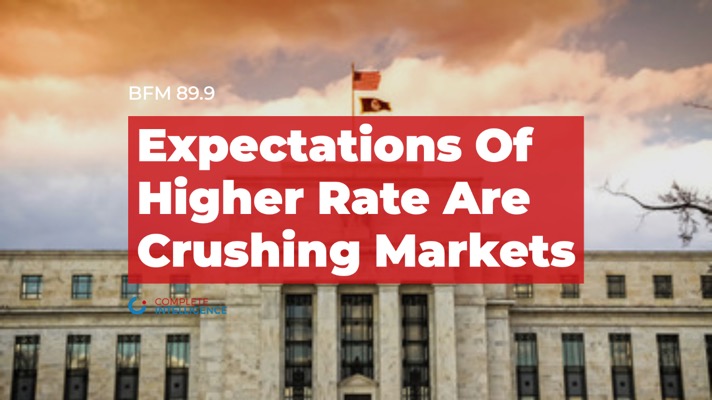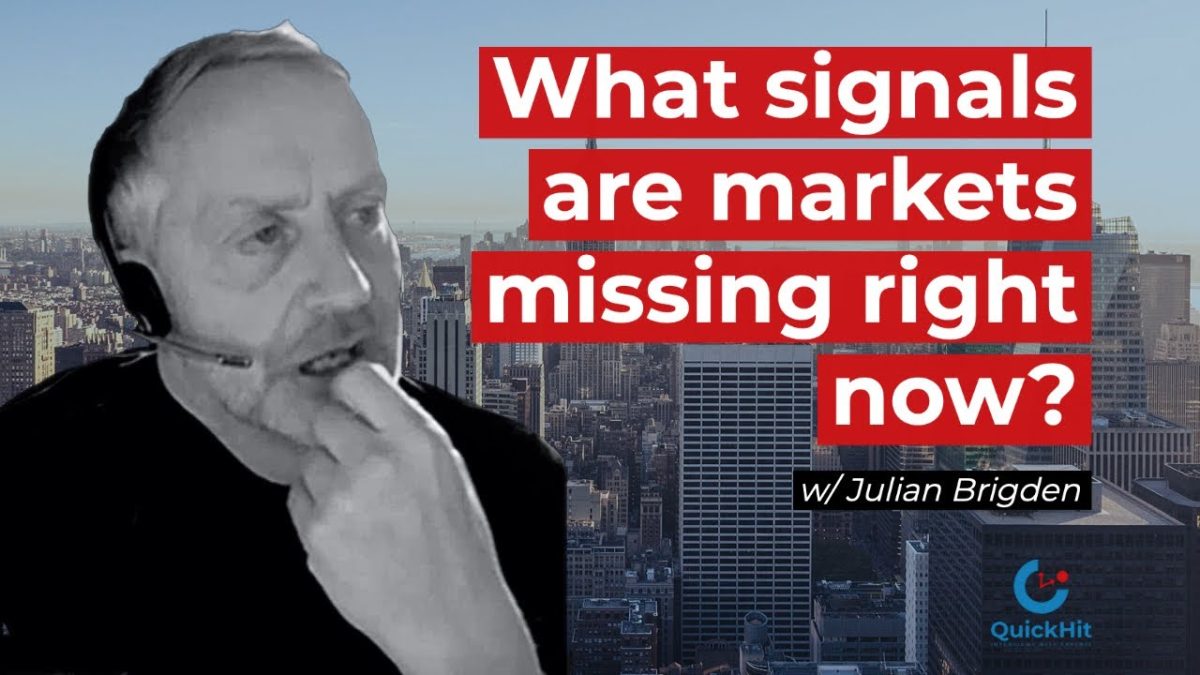In this QuickHit episode, our guest Julian Brigden answers “What signals are markets missing right now?” How important is the equity market right now in the current economic cycle? Most importantly, how long before we can see directional change in the market, and what you should do before then?
Julian Brigden is based in Colorado and started in the markets in the very late 80s, trading precious metals. He moved into trading FX, then switched into sales for various investment banks. He also worked for a policy consultancy group called Medley Global Advisors in the very late 90s to early 2000s and fell in love with the research space. Just over ten years ago, he set up MI2. MI2 was grown organically. Julian can be seen together with Raul from Real Vision where he does Macro Insider.
💌 Subscribe to CI Newsletter and gain AI-driven intelligence.
📊 Forward-looking companies become more profitable with Complete Intelligence. The only fully automated and globally integrated AI platform for smarter cost and revenue planning. Book a demo here.
📈 Check out the CI Futures platform to forecast currencies, commodities, and equity indices
This QuickHit episode was recorded on November 3, 2021.
The views and opinions expressed in this What signals are markets missing right now? Quickhit episode are those of the guest and do not necessarily reflect the official policy or position of Complete Intelligence. Any contents provided by our guest are of their opinion and are not intended to malign any political party, religion, ethnic group, club, organization, company, individual or anyone or anything.
Show Notes
TN: Julian, I’ve watched a lot of your videos, and I love a lot of the thoughts you’ve talked about recently about velocity, about the yield curve, about central banks. It’s all great stuff. I guess one of the things that I’m really wondering right now, especially, is what is the market missing? What are market participants missing? Because this is something that I don’t hear a lot of talk about. We hear a lot of the Fed should do this or this asset is going that way or whatever. But what is the market missing right now?
JB: Right. So we’ve been on this inflation gig since, actually, March of 2020. Sorry. Apologies. So at the depths kind of the pandemic. It’s a very long thesis. I’ve probably been in the inflation court really since the end of 2016. But in this sort of current phase, and we’ve been in and out of them, you have to. That’s what markets are about. We have been on this inflation kick since March of 2020. And initially it was just a trade breakevens, which are a metric of inflation in the bond market had got crushed because they were held by the risk parity boys as their inflation hedge in their portfolios. And they delevered like everyone else did in the spring of 2020. And those things dropped to like, five-year inflation was priced at 50 basis points.
Well, Tony basically trades the cycle, right. So as the economy recovers, which you had to assume it would, they were going to come back. But as we’ve sort of taken a step back and from a bigger picture perspective, we’d always said that even as soon as Trump came in, when you start playing with just monetary, that’s one thing. But when you add that fiscal side into the equation, into the mix, it becomes totally and utterly different.
And we’ve actually always used the period from the mid 1960s to the late 1960s. That’s where I kind of think we are. So we’ve had these sort of pro-cyclical, unnecessary, excessively large fiscal stimulus. And they came to create this accelerative oscillation. Okay. So I’ve got a couple of very smart ones, way smarter than me.
Classic example of the A students working for the C student. And we were looking at inflation back in 2016, and I was just looking at the chart in the 60s, and my quant came up to me and went, Boss, that’s an accelerative oscillation. And I said, Steven, what the hell is that? And he goes, well, he was, by the way, he was a mining expert, specialized in explosives. And he said, kind of what you do when you model an explosive wave is it goes out in a wave until it hits something. And if it hits it at the wrong time, far from the wave decelerating because you expected to hit something and stop, it can actually accelerate the oscillation of the wave. And so essentially, from an inflation perspective is that the way that you think about this is you get something like the Trump stimulus, which was back in late 2016, totally unnecessary fiscal stimulus at the wrong point of the cycle, where we didn’t need it.
So far from sort of rolling over like a sine wave, which the economic cycles behave that way, too. And inflation cycles generally behave that way because of self limiting on the tops and the bottom, cycle actually picks up amplitude. And what you tend to do is you create policy error after policy error after policy error because you’re behind the curve all of a sudden, you know what it’s like in trading, right?
If you’re on your game and you’re short something or long something and it moves in your direction, you might take some profit. Look for the retracement, double up, whack it hard. You get caught the wrong way into the move and your head just becomes discombodulated. And that’s what happens from a policy perspective. So. When I look at this current situation, the first thing I would say is I think people are, they’ve finally woken up to this concept that maybe inflation is not transitory. I think they’re right. We’ve been on this gig for a long time, but the immediate risks, I think, are twofold.
The first one is they are not. And it’s not necessarily here in the US. I think it’s going to be a problem here in the US, but I think it could be a bigger problem, actually, in Europe and for the bond market that matters because all those bond markets are all fungible. Right. So if bonds blow out or your eyeboard, the front end contracts in Europe blow out, it’s all going to affect our markets over here. And. They’ve totally underestimated the price pressures in the pipeline.

Budget automation with Complete Intelligence takes the months of work into minutes, resulting in impressive revenue and cost forecasting accuracy.
☎️Learn exactly how much faster your forecasting, budgeting, and planning can take place.
Book a time with our expert.
TN: In Australia, right?
JB: Yeah, we have. But not. I think we’ve got another maybe three months of numbers of I think could make people’s eyes bleed. You’ve got this price pressure in the system. Three possible outcomes. Price pressures dissipate. PPI pressures just dissipate. Okay?
Well, we just got the market survey this last week. Pressures are up. We just got the ISM services. Price pressures are back up to the previous highs. We just got the Swedish service thread bank PMI services yesterday. Price pressures at new highs. Okay.
TN: China’s PPI are like 14% or something year on year, right?
JB: Exactly. And their PMI price pressure number, which was dropping, just re accelerated. So option number one, that somehow price pressures just miraculously evaporate, doesn’t seem like an option. Option number two, the companies eat the price increases. They take them in margins. Well, if that’s the case. And this is one of the things the equity market hasn’t woken up to, then your assumptions on margin growth are. The good stuff that you can get here in Colorado, right.
Now thus far in the United States, it’s absolutely not the case, right? Companies are pushing through those price increases. Okay. Which brings you to option number three. Price inflation, given where these PPIs are, right? So US, even the final demand, the new sort of slightly adjusted, surprising how when they do adjust these things, Tony, they generally drop from the old metric?
Now it’s like, two and a half to 3% under the old PPI series. But anyway, it doesn’t matter. Eight and a half percent here in the US. I think we printed another 45 high in Sweden. And I’m picking Sweden because it’s a nice open economy. And you see the data come through very quickly. I think there’s one of those 17%. Spain, 23. Eurozone, 13 and a half. Okay. So higher than the US.
If companies can pass those price increases on, what makes people think for a nano second that CPI is going to stay here in Sweden at two and a half in the Eurozone at four. Why couldn’t Eurozone HICP, which is their CPI, which is max only ever had a 5% spread to PPI, right? At the moment, we have a nine plus spread. Why couldn’t HICP print somewhere, my guess is between eight and a half and eleven?
TN: So those are Chinese figures?
JB: Yeah. Exactly. What the hell does this? Do you think Lagarde is going to be able to say, like King Canute, “stop?”
TN: So in one of your interviews that I watched, you said central bank assets and inflation are effectively the same thing. And I think that’s really interesting. Can you explain that a little bit?
JB: So the balance sheet? Yeah. Essentially. Look, you print money, which is what it is. QE is printing money. Monetary 101. This is how the Roman Empire ended up falling apart. And you can inflate asset prices because I know this is not how central banks initially told you it worked actually. Having said that, I do love it. And we’ll come to this, I think the second point, the markets are missing in a second, and another central banker.
The only central banker who’s been truly honest was Richard Fisher, the old Dallas Fed central bank chairman. And I love the Texans from the Dallas Fed because they’re just straight shooters. They’re just bloody honest, right? I mean, he came out on CNBC, and I remember watching this interview because it was done on CNBC Europe, I think. And the guy always had one of the British guys on CNBC in the US. The guy nearly fell off his damn chair when Richard Fisher said, “of course, it was about the equity market. It was always about the equity market.” Right.
We just front load this stuff and they could boost asset prices. And you can look at the PA of the S&P. You can look at the S&P itself. You can look at the NYSE, you can look at the value line geometric index, which is a super broad metric of US Equities, and you can put them all against the Feds balance sheet. And it’s the same thing.
TN: Let me ask you this. And I hear you and I am aligned with what you’re saying. The question is, why does it have to do with the equity markets? And my understanding is that it has to do with equity markets because that’s where American 401Ks are. And there’s such a large baby Boomer cohort with their money in 401Ks that they can’t be losing their wealth. Is that the reason why it’s always about equity markets?
JB: Well, I mean, I say it’s housing as well, right. But they tend to try and deemphasize that one because politically, that can be a bit of a pain in the ass. Right. But look, this is true monetary debasement 101, right? I mean, we wrapped it up in this veneer that is G7 central banking or the sophisticated theories. But we’ve done this throughout history, right? We just debased the currency.
People forget in the Weimar Republic, the Reichsmark was imploding in value. Sorry, the pre-Reichsmark was imploding in value, and the stock market was going up thousands of percent today to keep phase with this because it’s a claim on a tangible asset, right? A cash flow or a piece of land or a factory or whatever, right? So this is not new. I think this is. No, I think it’s not so much about the 401Ks. The thing that I think is truly problematic in the US is what I refer to as the financialisation of the real economy.
Tony, that CEOs are not paid to produce a thing. There are actually numerous companies in the S&P that I’ll argue don’t produce anything, right? They are simply an utterly shepherds of an equity price. That’s how they’re compensated. We talk about perverse incentives. Okay. That’s how they’re compensated. They basically compensate to bubblish their stock as much as they possibly can.
And as a result, the minute that stock prices got going up, let alone fall. They look immediately to the bottom line as to how to address costs and keep those profits falling. So if you look at the correlations between, and it’s just frightening, the correlations between total US employment and the NYSE, broad metric of US Equities, Capex and NYC. They’re the same bloody chart.
TN: Sure.
JB: So literally, you can’t really allow stocks even to go sideways for an extended period of time. You’ve got to keep this game go.
TN: Sure, it’s not the flow, right? We’re in a flow game. We’re not in a stock game.
JB: Bond markets much more flow in terms of the shape of the curve is much more a flow thing. Equities are really about, they care when the flows turned off, but they’re really about the quantity.
TN: Overall stock. Okay. So what else are markets missing?
JB: The second thing is I just want to raise this. There’s a really important Bloomberg story out today by Bill Dudley, the ex New York Fed President, ex Goldman guy. And once again, I love the honesty of these retired US Fed guys. And he’s been talking at some length about policy error. But today is fundamentally the issue.
So let’s use that old storyline. If a tree falls in the woods and no one hears it, did it fall? Okay. So in the last few weeks, we’ve had a lot of pressure at the front end of these bond markets. We built in rate hikes. And that’s a market assumption on what the Fed or ECB or the Bank of England or the RBA or whatever is going to do with their policy, right?
But at the end of the day, Tony, do we care what banks here in the US earn in the overnight from Fed funds? No. There’s literally no relevance unless you’ve got some sort of liable based funding mortgage. But really, essentially, even then, has no relevance to the real world. Right? Policymakers raise policy rates to affect broad financial conditions. And broad financial conditions are essentially five metrics depending on the waiting in every single index. And they are short term rates, let’s say two years. Long term rates, let’s say ten years. Credit, tightness. Level, equity market. And the Dollar.
And what you can see in the US and most other places is despite the fact that we’ve seen these big moves at the front end of these bond markets, financial conditions haven’t budged. Ten-year yields, if anything, have fallen. It’s a bare flattener. It’s kind of what you would expect at this point in the cycle. But nonetheless, there is no tightening coming from the ten year sector. Because there is no tightening coming from the ten-year sector.
There is no tight, not much tightening going on in the mortgage market, okay? Because there is no tightening coming from the ten-year sector, the equity market where the Algos literally just trade ten-year treasuries is their metric and wouldn’t know what a Euro dollar was, in order to fund the interest rate contract if it bit them in the proverbial ass, okay? Have completely ignored what’s going on. The dollar is caught in the wash between these various central banks who are all behind the curve and has gone nowhere. And credit hasn’t moved, because he’s looking at the equity market.
So there has been no tightening of financial conditions. What Bill Dudley said is that’s all that bloody matters. And so until there is a tightening of financial conditions in an economy which at least the President, probably, I suspect well into the middle of next year could change quite dramatically in the middle of next year. But for the moment, and that’s a eight, seven, eight month trading horizon, until there is a tightening of financial conditions, which means stocks down, credit wider, dollar up, ten-year yields higher. Those two year yields have to go further and further and further and further.
And this concept that the market is currently pricing, that we’re going to try and raise a little bit. And the whole edifice is going to blow up because they have what they refer to as the terminal rate, kind of the highest projection of where rates are essentially going to go in the tightening cycle is that one six is wrong.
We may have to go way through that. And Bill Dudley actually talks about 2004, 2006, where the Fed started off way behind the curve and the economy just kept running. Demand was there and they had to go 225 basis points and they had to do all sorts of other stuff before the damn things slowed down.
TN: True. When we consider that. So you’re saying, really seven, eight months before we see a major directional change in markets. I don’t want to put words in your mouth.
JB: Well, look, I think there’s sufficient, I do not see this as a slowing economy. I see this as an economy where demand is utterly excessive because central banks and policy makers misread. I think it was a fair mistake to make. I’m not critical of that, misread Covid.
TN: Sure. Policy errors are all over the place.
JB: All over the shop. Right. So we have far too easy, excessive policy. Right. Look, today the Fed is going to taper, but let’s be honest, tapering isn’t tightening. Tapering is less easing. We are driving into the brick wall that is the output gap, right. The economy at full capacity, not at 120 billion a month. But let’s say from next month, 105. Right. If you drove into a brick wall in your car at 105 versus 120, I think it would make very little difference to the outcome.
TN: That’s a good point. But we all remember the taper tantrum. So will we see a bit of a breather in markets before things amp up again? Or do you think people are just going to take and stride this time?
JB: I don’t think we get a taper tantrum this time. I think the Fed has been pretty clear. You’re sort of getting a little bit of a taper tantrum at the front end of these bull markets. But because most of the world doesn’t look at wonks like me, care what EDZ3 is, right? Or LZ3 in the UK, right? Or Aussie two year swaps. But most people don’t, aren’t aware of them, and they should be. But I mean, that’s what policymakers have to watch.
And as I said, I think the bigger thing is how far the rates have to go in an economy where demand is literally off the charts, where we’re seeing wage growth in the private sector from the ECI at 4.6%, where John Deere factory workers just rejected a 10% wage increase this year with following subsequent increases that probably work out around six odd percent over the next five years where they just said, forget it. Not enough, right? Not enough.
TN: Look at retail sales. The stepwise rise in retail sales over the past six months is incredible how quickly.
JB: I’m looking at stuff and if you look at the senior loan, which is the banking where they ask the bank loan offices what they intend to lend and who they’re lending to, and are they tightening conditions or whatever. Lending, they’re falling over backwards to try to lend money. Now we know that people have got some cash on sidelines because of the stimulus.
We know that companies have still got PPP loans that they’re still working through. So demand is a little lower, but supply is literally off the chart. So lending bank willingness to lend to consumers, decade highs, right. Bank willingness to lend to companies all time survey highs, 30-year highs. Right. So even if we were to get and I don’t think this is the case, even if wages would not keep space with inflation next year in the US, people have got plenty of places to go and borrow money to keep consuming.
So I just think this is an economy which is in the middle of its cycle. I mean, most cycles are three years long, three plus years long, with 15 months 16 months into this thing. I mean, this is mid cycle stuff. It’s the easiest of easy money, right?
TN: Okay. And so just kind of to end the three-point sermon, what else are markets missing? This is really interesting for me because I’m hearing a lot of different kinds of thesis out there every day, but very few about kind of what the market’s missing.
JB: Look. And I think it comes back to the final point, which we alluded to earlier. The equity market is making an assumption, of course, the equity market, I’m a bond guy and an FX guy. I hate the equity market. My glass is absolutely, defensively, half empty. Right. And ideally someone’s paid in it. But that’s the best day for it. That’s like the best market for me. Right. But the XG market is doing its classic thing where they’re just assuming the best of both worlds. So they’re assuming that margins are going to grow, so there is no cost pressure that could infringe on those. And we’re starting to see that.
I think Q4 numbers that we get in Q1 will start to get a little bit more interesting. Right. But we sure what wild wings or whatever the thing is called the Buffalo Wing place just got stumped because their wage costs were up and their input costs were up and they couldn’t pass it on. Right. But the equity market, as is classic, has taken the highest margins in 20 years, which is what we have now. And they’ve assumed that next year it grows even more. And in ’23, it grows yet again. Okay.
So as I said, if you’ve got this cost push and firms can’t pass it on, that doesn’t happen. Margins get crushed. Don’t think that’s a risk here in the US at the moment. Do think that’s a risk in Europe because these PPI increases are just so large. Right. And if you’re a Spanish company and your PPI went up 23.6%, you cannot pass on 23.6% increases to the consumer. In the US, if your prices went up eight and a half, you can wiggle a little bit through productivity, maybe a couple. You can probably get away with 5% price increases. Okay. So margin assumptions may be utterly wrong, but if they aren’t, what does that mean, Tony? It means that price inflation is rising, and in which case inflation is not transitory. And that’s the second big assumption. So they’ve assumed margins rise. Oh, and conveniently, inflation is transitory. And that in a cost push environment, you can’t square that circle. Right. One has to be wrong.
My gut is at the moment, it’s the latter in the US, not the former, more worried about the former in Europe in Q4. But that’s another thing, which I think the market has miraculously misread. But as I said, as those pricing pressures come through, I think policymakers and markets will have to adjust significantly. And I think it set us up for a policy error sometime next year. Probably huge. Probably.
TN: We’ll trip over ourselves with policy errors until we see this. And then when we do see some sort of reckoning, we’ll have even more policy errors.
JB: Correct. As Raul and I say constantly on Macro Insiders you just do buy the dip. You just got to figure out when the dip comes because you don’t want to be in when the dip comes and when you hold your nose and grab your bits and decide that you’re going to jump into the deep end and buy it by the seller.
TN: Great. Julian, thank you so much for your time. This has been fantastic for everyone watching. Please subscribe to our YouTube channel. It really helps us a lot to get those subscribers. And Julian, I hope we can revisit with you again sometime soon. Thanks very much.
JB: Thanks. Bye bye.









